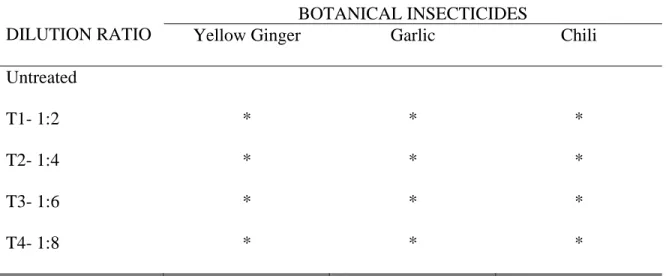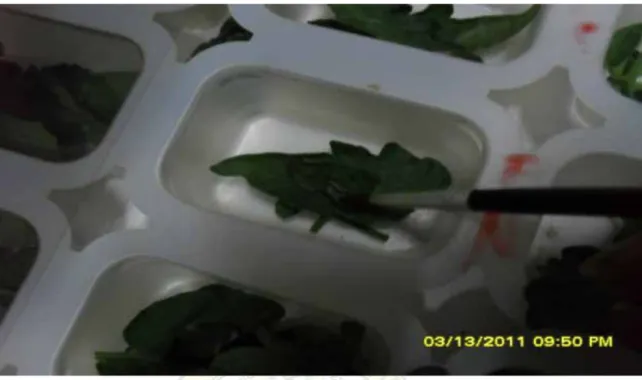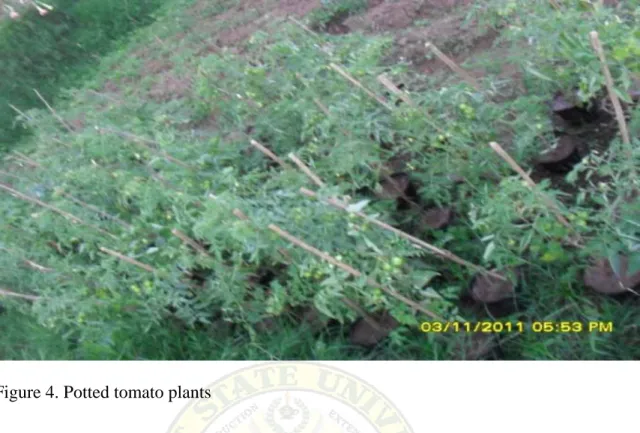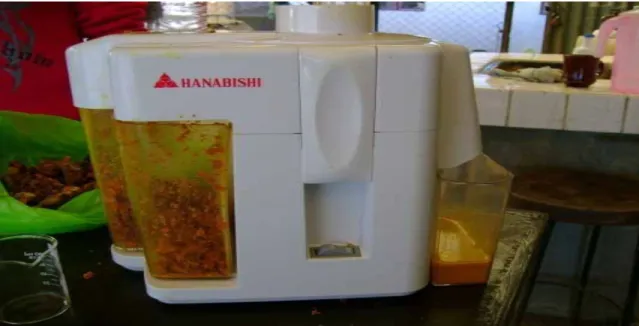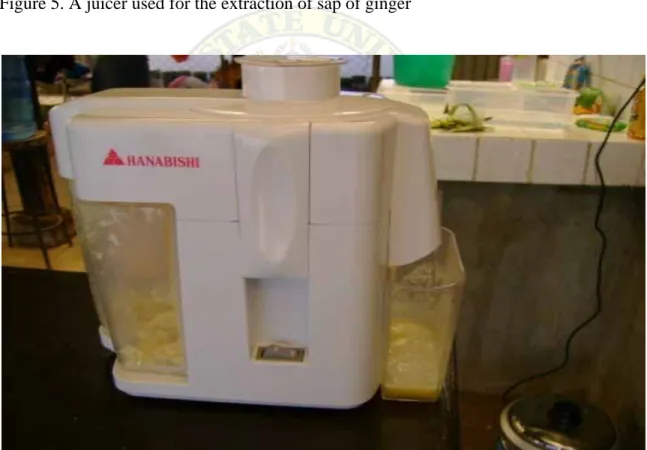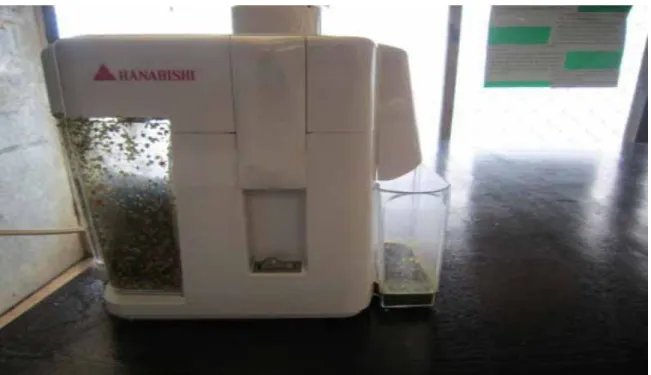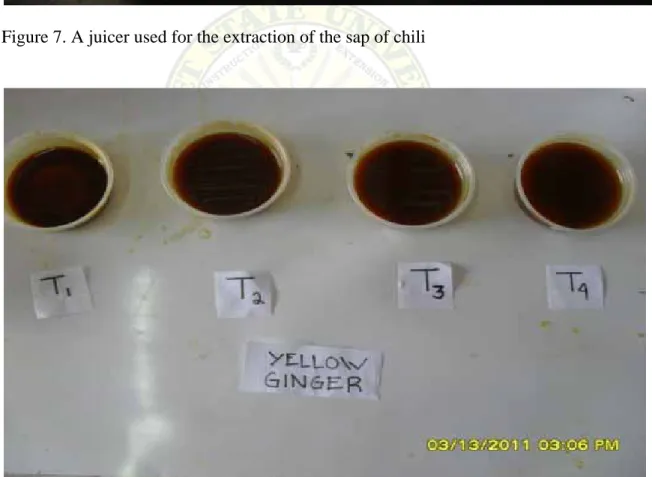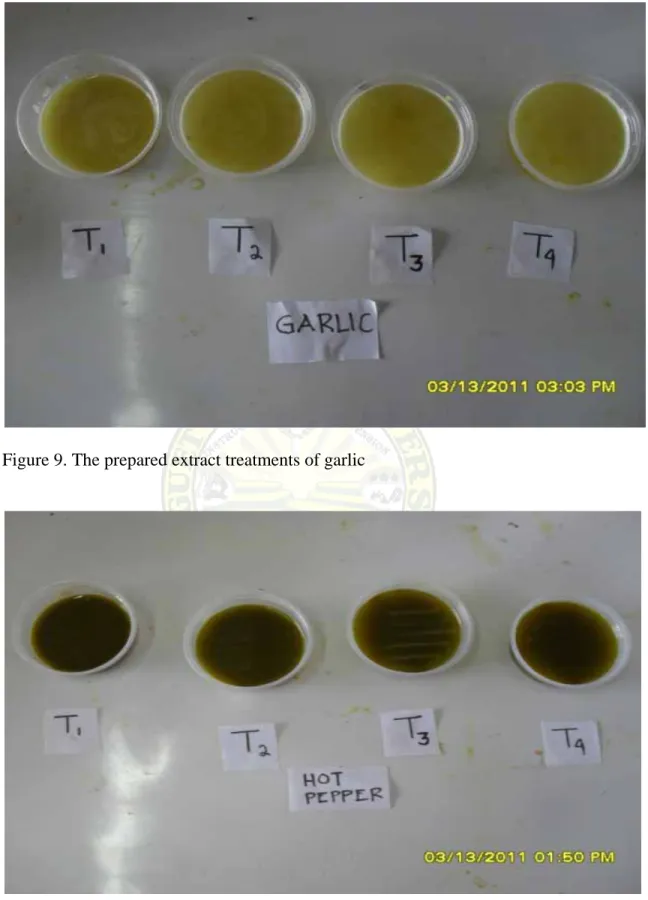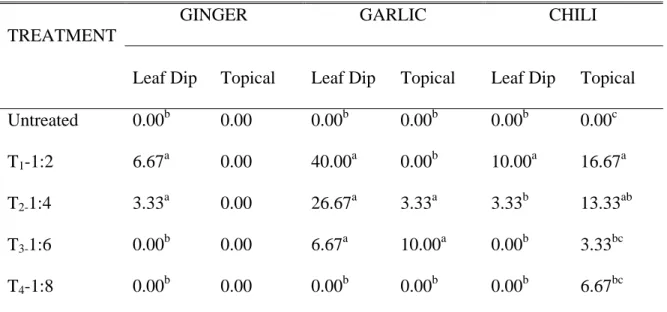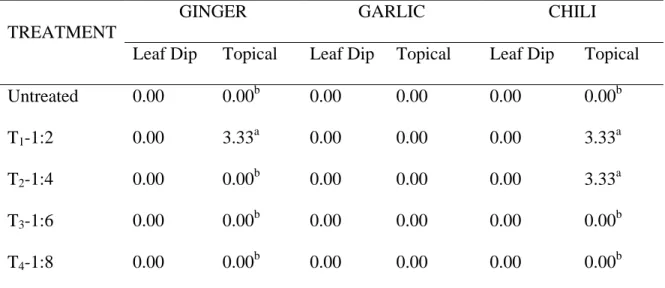BIBLIOGRAPHY
OWABAN, JORDAN A. APRIL 2011. Control of the Major Insect Pest of Tomato (Lycopersicon esculentom L.) With the Use of Selected Botanical Insecticides.
Benguet State University, La Trinidad Benguet.
Adviser: Eulogio V. Cardona Jr., PhD.
ABSTRACT
This research was conducted purposely to determine the insecticidal efficacy of ginger, garlic and chili for the control of fruit worm, whitefly and aphids in tomato, to identify the rate of the botanical insecticides economically effective against the insect pests of tomato and to determine the mode of actions of the botanical insecticides.
The extracts of yellow ginger, garlic and chili with the dilution ratio with water are the treatments and they are as follows: 1:2, 1:4, 1:6 and 1:8. Untreated was included as the basis for comparison. The treatments were applied by leaf dip and topical method for fruit worms and aphids. The extracts were applied by spray on potted tomato pots using the same dilution ratio for the efficacy against white flies.
There was a good control of fruit worms by the used of garlic at the dilution ratio of 1:2 and a slight control with the dilution ratio of 1:4. The degree of control was 40%
and 26.67% respectively. Good control of fruit worms was not observed from any of the treatments of yellow ginger and chili. Not any one of the treatments of yellow ginger, garlic and chili showed a control of aphids. Chili was slightly effective for the control of
white fly. Yellow ginger is not phytotoxic in tomato. Garlic and chili are phytotoxic at the dilution ratio of 1:2 and 1:4.
TABLE OF CONTENTS
Page
Bibliography……….……….. i
Abstract……….………... i
Table of Contents ………..……… iii
INTRODUCTION………....……….. 1
REVIEW OF LITERATURE………...………. 3
MATERIALS AND METHODS………...……… 6
RESULTS AND DISCUSSION Yellow Ginger, Garlic and Chili Effects on Fruit Worm ……….….……… 15
Yellow Ginger, Garlic and Chili Effects on Aphids…………....………….. 16
Yellow Ginger, Garlic and Chili Effects on Whitefly…………..…..…… 17
Phytotoxicity Yellow Ginger, Garlic and Chili………..………… 18
Color and Texture of Dead Insect………...………..………. 19
Mode of Action………...……….………..……… 23
SUMMARY, CONCLUSIONS AND RECOMMENDATION Summary………..……. 24
Conclusions………...….. 25
Recommendation ………..……… 25
LITERATURE CITED………..……….... 26
APPENDICES………....……… 27
1
INTRODUCTION
Tomato (Lycopersicon esculentum L.) is an edible fruit vegetable widely cultivated in almost all parts of the country. Here in the highland areas of the country, tomato is widely cultivated in Ankileng, Sagada of the Mountain Province and in some parts of Benguet Province. Similarly, tomato is widely trade in the area considering its versatility, reasonable cost and nutritive value. There are many varieties of tomatoes but the locally grown varieties are used either for household consumption. Tomatoes like other vegetables are nutritionally rich in vitamin C. It is also one of the most popular vegetable because of processing purposes. Today, tomato is one of the corner stone’s of modern diets.
One of the most destructive insect pests that are associated damaging tomato both in the field and in the greenhouse is fruit worm (Heliothis zea). Other insects of economic importance are aphids (Myzus persicae) and whitefly (Bemesia tabacci). The larval stage of fruit worm is the destructive stage. The insect chew deep holes on the fruit and stem of tomato. On the other hand, both the adult and nymph stages are destructive by sucking the sap of the plants. This insect feeds in group and they prefer the shoots or the young leaves of the tomato plants. Aphids (M. persicae) and whitefly (Bemesia tabacci) damage by sucking the leaf tissues of tomato. Whitefly causes foliar mottling and poor plant growth by sucking the sap of leaf tissues using their piercing-sucking mouthparts.
Commercial insecticides are the common method of controlling the insect pests of tomato. Synthetic insecticides are preferred because the effect is quick and readily available when needed. On the other hand, insecticides pose many disadvantages like
2
being harmful to the health of mankind. Secondly, insecticides are harmful to natural enemies like parasitoids and predators and so as with the wild lives like birds and frogs.
An alternative to the toxic synthetic insecticides is very necessary and one possible alternative are botanical insecticides. Literature indicates many edible plants, grasses and weeds with insecticidal importance like ginger, onion and hot pepper. Some are naturally occurring, by growing along creeks in the area like the sweet flag. Being botanical, they are not hazardous unlike the synthetic insecticides and their importance must be exploited in the area of insect pest control in tomato.
The objective of the study were to determine the insecticidal efficacy of ginger, garlic and chilli as an alternative against the synthetic insecticides for the control of fruit worm, whitefly and aphids in tomato, to identify/determine the rate of botanical insecticides economically effective against the insect pests of tomato and to determine the mode of actions of botanical insecticides.
The study was conducted at the Balili Experimental Station, Benguet State University, La Trinidad, Benguet from November 2010 to March 2011.
3
REVIEW OF LITERATURE
Insect Pests of Tomato and the Nature of Damage
In 1991, Nielsen and Common stated that tomato fruit worm is one of the major insect pests of tomato. The insect belongs to the order Lepidoptera of the family Noctuitidae. Fruitworms (Heliothis zea) are small to large; ocelli, usually present;
Antenna pectinate, dentate or simple; proboscis usually strong; maxillary palpai segmented palps and tarsi sometimes ascending; epiphysis present; tibial spurs 0-2-4, tibia and tarsi sometimes spinned; and forewing usually with aerol.
In 1977, James reported that tomato fruit worm (Heliothis zea), aphids (Myzus Persicae) and whitefly (Bemesia tabacci) are the major insect pest of tomato. Fruit
worms are commonly attacking tomato plants three weeks from planting. They infest plants in a much higher degree when the plants started to bear fruits. However in 1962, Metcalf et al. claimed that fruit worm (Heliothis zea) is injurious on tomato. Similarly, Penton in 1952 reported that the greatest damage by fruit worm is usually in the spring.
This is due to the larger size and more various appetites of the larva.
Description of the Insect Pests of Tomato
Adult fruit worm (Heliothis zea) is active at night time. The egg hatches 2 to 3 days after laying and the larval stage lasted for 14 to 21 days. The larva moves to the green fruit soon after hatching where they bore deeply into the fruits. Tomato fruit worm pupates in the soil. The adult emerge 7 to 14 days from pupation (Colting et al., 2003).
Fruit worm (Heliothis zea) according to Colting et al. (2003) is medium size moth with a wing span of 1 to 1.3 inch or 25 to35 mm. They are tan to medium brown or
4
sometimes have slight greenish tinge. The front wings are variously marked and usually have an obscure dark spots in the center and lighter bad inside a dark band around the tip.
The hind wings are white and have a dark gray bad around their tip. A diffuse light spot is in the center of dark band.
Aphids (M. persicae) are small, soft-bodied insect which maybe green, yellow, brown, red or black depending on the species and plants that they feed on. These insects feed in groups and generally prefer new, succulent shoots or young leaves. Adult aphids can be winged or wingless (Anonymous, 2001).
Whitefly (Bemesia tabacci) is one of the dominant problem insects of tomato.
Whiteflies cause foliar mottling and poor plant growth by sucking sap from leaf tissues of tomato using their piercing-sucking mouthparts. They also produce honeydew, a sticky sweet fluid where mold grows. This pest can complete a life cycle in 21 to 45 days and in a short time several generations may coexist and spread over a wide area (Encarta, 2004).
Botanical Plants
Chili. Aphids, caterpillar and thrips can be controlled by a concoction of hot pepper (Capsium annum), Chilli pepper has a repellent and a contact action on insects (Mabesa et al., 2005). The substances that give hot peppers their intensity when ingested or applied topically are capsaicin (8-methyl-N-vanillyl-6-nonenamide) and several related chemicals, collectively called capsaicinoids. Capsaicin is the primary ingredient in pepper sprayicide.
Garlic (Allium sativum) is a species in the onion family Alliaceae. Garlic has been used throughout history for both culinary and medicinal purposes. The garlic plant's bulb is the most commonly used part of the plant. Garlic is a very good all-purpose insect
5
repellent that can be used in several different ways to ward off pests. Garlic in its simplest form is used to keep insects off of several plants. Companion planting or placing plants together for a mutual benefit, works especially well with garlic. When crushed, Allium sativum yields allicin, a powerful antibiotic and antifungal compound. It has been
claimed that it can be used as a home remedy to help speed recovery from strep throat or other minor ailments because of its antibiotic properties. It also contains the sulfur containing compounds alliin, ajoene, diallylsulfide, dithiin, S-allylcysteine, and enzymes, vitamin B, proteins, minerals, saponins, flavonoids, and maillard reaction products, which are non-sulfur containing compounds.
Ginger (Zingiber officinale) is a tuber that is consumed whole as a delicacy, medicine, or herb. It lends its name to its genus and family (Zingiberaceae). Other notable members of this plant family are turmeric, cardamom, and galangal. Ginger cultivation began in South Asia and has since spread to East Africa and the Caribbean. It is sometimes called root ginger to distinguish it from other things that share the name ginger. The oleoresin of ginger is often contained in digestive, antitussive, antiflatulent, laxative, and antacid compounds (Anonymous, 2010).
6
MATERIALS AND METHODS
The materials needed for the study are as follows: 6 inches diameter clay pots, 8 x 4 plastic container, chicken manure, fungicide, shovel, watering can, sacks, knife, juicer, 16 celled tray, hair brush, garlic, ginger, and hot pepper.
Methodology
A. Efficacy of Yellow Ginger, Garlic and Chili Against Fruit Worms and Aphids
1. Preparation of Tomato Plants in the Field and the Rearing of Fruit Worms and Aphids Fruit worm larvae and aphids infesting the tomato plants in the open field were the test insects. To cope up with the population of insects, the experiment was done on staggard basis. Insects of similar sizes or approximately the early 3rd instars were the focused of collection for the study. The collection area for tomato was 150 square meters. The plants were grown by following the required cultural practices. On the other hand, insecticides were not applied to encouraged insect build up (Figure 1).
Figure 1. Tomato plants in the open field for the collection of fruit worms
7
2. Preparation of Extracts and the Treatments
Yellow ginger, garlic and chili the plants common in the market were the source of the extracts. The rhizomes of ginger, the cloves of garlic and fruit of chili after being chopped into small pieces were placed inside the juicer where extraction was done. After extraction, the extracts were poured on clean bowl. The ratio of extracts and water served as the treatments. The details of the treatments are as follows.
Each of the treatment preparations was represented by a hundred grams of chopped materials. The topical method of treatment application and leaf dip method were followed in determining the efficacy of the extracts.
a. Topical Method of Treatment Application
The treatments were topically applied by brushing the dorsal surface of the insect body using hair brush dipped on the extracts. Immediately after treatment applications, the insects were placed on plastic tray containers (Figure 2). The trays consist of 16 cells
Table 1. Treatments and the ratio of extract and water
DILUTION RATIO
BOTANICAL INSECTICIDES
Yellow Ginger Garlic Chili
Untreated
T1- 1:2 * * *
T2- 1:4 * * *
T3- 1:6 * * *
T4- 1:8 * * *
8
Figure 2. Fruit worm larvae topically applied with the extracts/toxicants
with one fruit worm larva contained for every cell. Untreated sliced tomato leaf was provided as food. The trays were covered to prevent escape. The treatments including the untreated were replicated 3x. Each of the replications was represented by samples of 16 larvae. The test units were stored under laboratory room temperature. Insect from the trays were evaluated for dead and alive 72 hours after treatment.
b. Leaf Dip Method of Treatment Application
Leaves were collected in the open field and dipped on the extract treatments of yellow ginger, garlic and chili. Dipping lasted for 10 seconds (Figure 3). After dipping, the leaves were placed on a paper towel bottom side up until the surfaces of the leaves were dried. After an hour of air drying, the leaves were cut into small pieces with a size fitted to cell of the tray container. The leaves were placed directly to the cells of the tray.
9
Figure 3. Leaves of tomato were laced with the extract/toxicants by leaf dip method
Only one leaf was placed in each of the 16 cells of the tray. Immediately after, one early 2nd instar fruit worm larva was likewise placed in each of the 16 cells of the tray. The trays were covered to prevent escape. The treatments were replicated 3X with one tray representing the replication of the treatments. Test units were stored under laboratory room temperature. Insects from the trays were evaluated for dead and alive 72 hours after exposure from the treatments. Efficacy of yellow ginger, garlic and chili by leaf dip method was not done for aphids.
B. Efficacy of Yellow Ginger, Garlic and Chili against White Flies 1. Preparation of Potted Tomato Plants
The host tomato plants were grown on clay pots inside the green house at the Diadegma Rearing House at BSU, La Trinidad Benguet. The pots were filled with soils where the seeding of tomato was done. To come up with vigorous plants, the soil was
10
Figure 4. Potted tomato plants
enriched with nutrient using chicken manure through mixing at a proportion of 1:1. All important cultural requirements of tomato plants like watering, fertilization, disease prevention was employed. On the other hand application of insecticides was not employed to encourage the build up of the White flies (Figure 4).
2. Preparation of the Extracts and the Treatments
The methodology for the preparation of extracts of yellow ginger, garlic and chili (Figure 5-7) for the efficacy experiment against fruit worms was similarly the methodology employed for the extraction on the efficacy against white flies. The extract and water ratio was likewise the same in all the treatments (Figure 8-10).
11
Figure 5. A juicer used for the extraction of sap of ginger
Figure 6. A juicer used for the extraction of the sap of garlic
12
Figure 7. A juicer used for the extraction of the sap of chili
Figure 8. The prepared extract treatments of ginger
13
Figure 9. The prepared extract treatments of garlic
Figure 10. The prepared extract treatments of chili
14
3. Application Procedures of the Treatments
The treatments were applied by spray using the 1 liter capacity hand sprayer.
Application was done 3x followed by the assessment of the population of white flies.
Each of the replication consists of 5 potted tomato plants. The population of white flies was assessed using the 1-9 population rating scale index. The details are as follows: 1- no adult white flies present, 3- very few population of adults present, 5- some population of adults present, 7 - many population of adults present and 9- huge population of adults present. All the 5 potted cabbages were samples in determining the population of white flies. In evaluating the phytotoxicity of the treatments, the 1-9 FPA phytotoxicity rating scale index was used. The details are as follows: 1= no crop injury, 3=1 to 10% crop injury, 5=11 to 20% crop injury, 7=21 to 30% crop injury and 9=>than 30% crop injury.
Assessment for phytotoxicity was done using all the 5 potted plants as samples. All the treatments were arranged in following the completely randomized design (CRD) with 3 replications.
15
RESULTS AND DISCUSSION
Yellow Ginger, Garlic, and Chili Effect on Fruit Worms
The effect of yellow ginger, garlic and chili on fruit worms is presented in Table 2. Mortality due to yellow ginger was noted on the leaf dip method of application. As presented however, the mortality was not as big equivalent to only about 6.67% and 3.33% which was caused by the ginger dilution ratio of 1:2 and 1:4. Mortality was not noted from the treatments with the dilution ratio of 1:6 and 1:8 similar with the untreated.
Mortality of fruit worms by topical application was not noted from any of the rates of ginger.
The mortality caused by garlic was noted on the leaf dip method of application and almost none from the topical method of application. As presented, the mortality considered highest was 40% which was caused by the dilution ratio of 1:2. The second highest was 26.67 % which was caused by the dilution ratio of 1:4 and 6.67 % from the dilution ratio of 1: 6. Mortality was not noted from the remaining treatments together with the untreated.
The mortality caused by chilli was noted in both leaf dip and topical method of application. The mortality from the leaf dip method which was the highest was 10.00%
and caused by the dilution ratio of 1:2. The second highest was 3.33% from the dilution ratio of 1:4. Mortality was not noted from the lower rates of chilli similar with the untreated.
Although not big, mortality of fruit worms was generally higher in the topical method than the leaf dip method. The highest mortality of fruit worms in the topical
16
Table 2. Mortality (%) of Fruit worms in tomato as affected by the treatments
TREATMENT
GINGER GARLIC CHILI
Leaf Dip Topical Leaf Dip Topical Leaf Dip Topical Untreated 0.00b 0.00 0.00b 0.00b 0.00b 0.00c T1-1:2 6.67a 0.00 40.00a 0.00b 10.00a 16.67a T2-1:4 3.33a 0.00 26.67a 3.33a 3.33b 13.33ab T3-1:6 0.00b 0.00 6.67a 10.00a 0.00b 3.33bc T4-1:8 0.00b 0.00 0.00b 0.00b 0.00b 6.67bc
*Means followed by a common letter are not significantly different a 5% level by DMRT
method of application was 16.67% and 13.33% which were caused by the dilution ratio of 1:2 and 1:4. A very small percentage of mortality was noted from the dilution ratio of 1:6 and 1:8. Mortality was not noted from the untreated.
Yellow Ginger, Garlic and Chili Effects on Aphids
Table 3 Present the percent mortality of aphids due to ginger, garlic and chili.
Although small, mortality was recorded on the dilution ratio of 1:2 of ginger. Mortality was not noted from the dilution ratio together with the untreated.
Mortality of aphids was not recorded from any of the dilution ratio for Garlic together with the untreated. Mortality of aphids was recorded from the two dilution ratio of chilli against aphids. The mortality however, was very small to negligible equivalent to only 3.33% and 3.33%, respectively which were observed from the two dilution ratio of 1:2 and 1:4. Mortality was not recorded from treatments lower than the dilution ratio of 1:4 similar with the untreated.
17
Table 3. Mortality (%) of aphids in tomato as affected by the treatments of ginger, garlic and chili
TREATMENT
GINGER GARLIC CHILI Leaf Dip Topical Leaf Dip Topical Leaf Dip Topical
Untreated 0.00 0.00b 0.00 0.00 0.00 0.00b T1-1:2 0.00 3.33a 0.00 0.00 0.00 3.33a T2-1:4 0.00 0.00b 0.00 0.00 0.00 3.33a T3-1:6 0.00 0.00b 0.00 0.00 0.00 0.00b T4-1:8 0.00 0.00b 0.00 0.00 0.00 0.00b
*Means followed by a common letter are not significantly different a 5% level by DMRT
Yellow Ginger, Garlic and Chili Effects on Whitefly
The effect of ginger, garlic and chilli on the population of whitefly is presented on Table 4.
It is presented in data table the presence of a few population of whitefly in all the treatments of ginger and garlic. Differences in both treatments however were not noted.
The said population of whitefly in all the treatments of ginger and garlic were comparable with the untreated.
Population of whitefly was not noted on the two highest dilution ratio of chilli. On the other hand, the said population was few to negligible. Whitefly was not noted from the treatments of chilli at 1:6 and 1:8 dilution ratios similar with the untreated.
18
Table 4. Whitefly population (rating scale of 1-9) on tomato as affected by the treatments
TREATMENT GINGER GARLIC CHILI
Untreated 3.67b 3.67a 3.67a
T1-1:2 3.67b 3.00a 1.00b
T2-1:4 4.33a 3.00a 1.00b
T3-1:6 3.67b 3.67a 1.00b
T4-1:8 3.67b 3.67a 1.00b
1-No population, 3- few adults present, 5- many adults present, 7- several adults present, 9- large number of adults present
Phytotoxicity of Yellow Ginger, Garlic and Chili
The data on the phytotoxicity effect of yellow ginger, garlic and chilli is presented in Table 5.
A rating of one was recorded in all the treatments of ginger. Since 1.0 signify the absence of phytotoxicity base on the rating scale index of 1-9, it implies that ginger is not phytotoxic on tomato.
A rating scale of 3.0 and 2.0 were recorded from the two dilution ratio of garlic of 1:2 and 1:4. From the treatment rates of 1:6 and 1:8 the phytotoxicity recorded were all 1.0 implying that the treatments were not phytotoxic.
A rating scale of 3.0 and 2.0 were recorded from the two dilution ratio of garlic of 1:2 and 1:4. The rating scale of 1.0 was recorded from the treatment rate of 1:6 and 1:8 implying that the treatments were not phytotoxic.
19
Table 5. Phytotoxicity (rating scale of 1-9) effect of the treatments on tomato
TREATMENT GINGER GARLIC CHILI
Untreated 1.00a 1.00c 1.00b
T1-1:2 1.00a 5.00a 5.00a
T2-1:4 1.00a 2.33b 1.67b
T3-1:6 1.00a 1.00c 1.00b
T4-1:8 1.00a 1.00c 1.00b
*means followed by a common letter are not significantly different a 5% level by DMRT
Color and Texture of Dead Insects
Dead fruit worm larvae due to yellow ginger were characterized with a black color of the insect body. The whole body is black and the texture is soft (Figure 11). On the other hand, the dead larvae due to garlic and chili have a body which are brown in color. Those killed by garlic, the brown color are confined on the center region of the body (Figure 13) while those dead larvae due to chili are brown in color the whole part of the insect body. The body texture of dead insect due to garlic was soft while the larvae due to chili was relatively firm (Figure 15).
The color of the dead aphids due to ginger was brown and the color of dead aphids due to garlic and chili were green.
20
Figure 11. Appearance of dead larva due to ginger extract
Figure 12. Healthy fruit worm larva
21
Figure 13. Appearance of dead larva due to garlic extract
Figure 14. Healthy fruit worm larva
22
Figure 15. Appearance of dead larva due to chili extract
Figure 16. Healthy fruit worm larva
23
Mode of Action
Knowing the mode of action of yellow ginger, garlic, and chili is one of the objectives of the research and based on the results generated, the said botanical plants have either a dual mode or a single type of action and these are the stomach or contact type.
Yellow ginger being not effective against fruit worm as evidenced by the small to negligible mortality, the mode of action could not be determined. On the other hand, garlic is claimed to have a stomach mode of action brought about by the high fruit worm mortality when applied by leaf dip method. It has no contact mode of action. Although not as toxic, chili has a stomach and contact mode of action.
As the mortality of aphids was small to negligible in all the treatments of yellow ginger, garlic and chili, the plants mode of action could not be identified,
24
SUMMARY, CONCLUSIONS AND RECOMMENDATION
Summary
The study was conducted at BSU, Balili Experimental Station, Benguet State University, La Trinidad, Benguet from November 2010 to April 2011, to determine the insecticidal efficacy of ginger, garlic and chilli as an alternative against the synthetic insecticides for the control of fruit worm, aphids and white fly in tomato, to identify/determine the rate of botanical insecticides economically effective against the insect pests of tomato and to determine the mode of actions of botanical insecticides.
The efficacy of yellow ginger, garlic and chili were determined using the extract at different dilution ratio as follows: 1:2, 1:4, 1:6 and 1:8. Untreated was included as the basis for comparison. The treatments of yellow ginger, garlic and chili were applied by leaf dip method and topical method for fruit worms and aphids. The extracts were applied by spray on potted tomato pots using the same dilution ratio for the efficacy against white flies.
The results of the experiment indicated a good control of fruit worms by the used of garlic at the dilution ratio of 1:2 and a slight control with the dilution ratio of 1:4. The degree of control as observed was 40% and 26.67% respectively. Good control of fruit worms was not observed from any of the treatments of yellow ginger and chili. Not any of the treatments of yellow ginger, garlic and chili showed a control of aphids. As to the control of white fly, the treatment of chili was slightly effective. Yellow ginger is not phytotoxic in tomato. At higher dilutions ratio of 1:2 and 1:4 garlic and chili are phytotoxic.
25
Conclusions
Garlic was relatively effective against fruit worms with the dilution ratio of 1:2 and slightly effective with the dilution ratio of 1:4 and when applied by leaf dip method.
Yellow ginger and chili are not effective.
Yellow ginger, garlic and chili are not effective against aphids either applied by leaf dip method or topical method.
Chili was slightly effective against whiteflies while effectiveness was not observed from any of the treatments of yellow ginger and garlic.
Yellow ginger is not phytotoxic in tomato. At the dilution ratio of 1:2 and 1:4, garlic and chili are phytotoxic.
Recommendation
Garlic is recommended for the control of fruit worms. The rate recommended is the dilution ratio of 1:2 or the dilution of 1 part extract and 2 parts water.
26
LITERATURE CITED
ANONYMOUS. 2010. GVU’s 8th WWW user survey. Retrieved August 16, 2010, from http://en.wikipedia.org/wiki/Chili pepper, Garlic, Ginger
ANONYMOUS. 2001. Safe Environment. Environment @ sfgov. Org . http:/ ff. Ca.
Us/ipm/ Aphids. Html.1p.
COLTING, L. M., B.S. LIGAT.,L L. G. LIRIO., J.C. PEREZ and J.P. PABLO. 2003.
Compendium of Insect Pest and Weeds Associated with Crops in the Cordillera.
Cordillera Highland Agricultural Resources Management (CHARM) Project. Cor.
Sto. Tomas Rd. Marcos Highway, Baguio Dairy Farm, Baguio City and Benguet State University, La Trinidad Benguet. P. 35.
ENCARTA. 2004. Whitefly. Encarta reference library 2004. Retrieved Augost 16, 2010 http. // www.encartalibref/hb.html. P.1.
JAMES, J.1977. A Comparative study of five different insecticides on tomato fruit worm.
BS. Thesis. Mountain State Agriculture College, La Trinidad, Benguet.
P. 28.
MABESA, R.C., O.K. BAUTISTA, and A.T. AQUINO.2005. A guide to the exciting and rewarding pursuit of growing vegetables and other edibles in containers.
Philippines Seed Industry Association (PSIA) under the Hight Value Commercial Crop Program of theDepartment of Agriculture (HVCCP-DA). P. 110.
METCALF, C. L., W.P.FLINTAND and R.M.METCALF. 1962. Useful and Destructive Insects. (4th edition). New York, San Francisco, Toronto, London: Macgraw Hill Book Company. Pp.402-406.
MOTLEY, T. J. 1994. The ethnobotany of sweet flag Acorus calamus (L.) Economic botany. Pp. 397- 421.
NIELSEN, E. S. AND I.F.B.COMMON. 1991. The Insect of Australia. Australia Brown Prior Anderson Pty. Ltd. P. 910.
PANERU, R.B.. 1996. Study on the effect of temperature, wheat moisture content maturity and harvested altitude of rhizomes on the toxicity of Acorus calamus (L.) powder to sitophilous oryzas (L.) and sitophilus granariuz (L.) mortality and their pogeny emergence. M.S. Thesis. Imperial College of Science and Technology,Ascot, Berkshire,SL 57 py England
PENTON,F.A. 1952. Field Crop Insect. The Mcmillan Book Company New York.
Pp. 260-262.
27
APPENDICES
Appendix Table 1. Mortality (%) of fruit worm in tomato as affected by treatment of - ginger extract (topical methods)
TREATMENT REPLICATION TOTAL MEAN
I II III
Untreated 0 0 0 0 0.00a
T1-1:2 0 0 0 0 0.00a
T2-1:4 0 0 0 0 0.00a
T3-1:6 0 0 0 0 0.00a
T4-1:8 0 0 0 0 0.00a
ANALYSIS OF VARIANCE
SOURCE OF VARIANCE
DEGREES OF FREEDOM
SOME OF SQUARES
MEAN SQUARES
COMPUTED F
Pr>F
Treatment 4 0.00 0.00 0.00ns 0.00
Error 10 0.00 0.00
TOTAL 14 0.00
ns- Not significant
28
Appendix Table 2. Mortality (%) of fruit worm in tomato as affected by treatment of - garlic extract (topical methods)
TREATMENT REPLICATION TOTAL MEAN
I II II
Untreated 0 0 0 0 0.00b
T1-1:2 0 0 0 0 0.00b
T2-1:4 10 0 0 10 3.33a
T3-1:6 10 0 20 30 10.00a
T4-1:8 0 0 0 0 0.00b
ANALYSIS OF VARIANCE
SOURCE OF VARIANCE
DEGREES OF FREEDOM
SOME OF SQUARES
MEAN SQUARES
COMPUTED F
Pr>F
Treatment 4 226.666667 56.6666667 2.13ns 0.1522 Error 10 266.666667 26.6666667
TOTAL 14 4573.33333
ns- Not significant
29
Appendix Table 3. Mortality (%) of fruit worm in tomato as affected by treatments of - chili extract (topical method)
TREATMENT RPLICATION TOTAL MEAN
I II III
Untreated 0 0 0 0 0.00c
T1-1:2 10 20 20 50 16.67a
T2-1:4 0 20 20 40 13.33ab
T3-1:6 0 10 0 10 3.33bc
T4-1:8 10 10 0 20 6.67bc
ANALYSIS OF VARIANCE
SOURCE OF VARIANCE
DEGREES OF FREEDOM
SOME OF SQUARES
MEAN SQUARES
COMPUTED F
Pr>F
Treatment 4 573.333333 143.333333 3.07ns 0.0683 Error 10 466.666667 46.6666667
TOTAL 14 1040
ns- Not significant
30
Appendix Table 4. Mortality (%) of fruit worm in tomato as affected by treatments of - ginger extract (leaf dip method)
TREATMENT REPLICATION TOTAL MEAN
I II II
Untreated 0 0 0 0 0.00b
T1-1:2 20 0 0 20 6.67a
T2-1:4 10 0 0 10 3.33a
T3-1:6 0 0 0 0 0.00b
T4-1:8 0 0 0 0 0.00b
ANALYSIS OF VARIANCE
SOURCE OF VARIANCE
DEGREES OF FREEDOM
SOME OF SQUARES
MEAN SQUARES
COMPUTED F
Pr>F
Treatment 4 106.666667 26.6666667 0.80ns 0.5520 Error 10 333.333333 33.3333333
TOTAL 14 440
ns- Not significant
31
Appendix Table 5. Mortality (%) of fruit worm in tomato as affected by treatments of - garlic extract (leaf dip method)
TREATMENT REPLICATION TOTAL MEAN
I II III
Untreated 0 0 0 0 0.00b
T1-1:2 30 50 40 120 40.00a
T2-1:4 40 10 30 80 26.67a
T3-1:6 10 0 10 20 6.67a
T4-1:8 0 0 0 0 0.00b
ANALYSIS OF VARIANCE
SOURCE OF VARIANCE
DEGREES OF FREEDOM
SOME OF SQUARES
MEAN SQUARES
COMPUTED F
Pr>F
Treatment 4 3840 960 13.09** 0.0006
Error 10 733.333333 73.333333 3
TOTAL 14 4573.33333
**-Highly significant
32
Appendix Table 6. Mortality (%) of fruit worm in tomato as affected by treatments of - chili extract (leaf dip method)
TREATMENT REPLICATION TOTAL MEAN
I II III
Untreated 0 0 0 0 0.00b
T1-1:2 10 10 10 30 10.00a
T2-1:4 0 10 0 10 3.33b
T3-1:6 0 0 0 0 0.00b
T4-1:8 0 0 0 0 0.00b
ANALYSIS OF VARIANCE
SOURCE OF VARIANCE
DEGREES OF FREEDOM
SOME OF SQUARES
MEAN SQUARES
COMPUTED F
Pr>F
Treatment 4 226,666667 56.6666667 8.50** 0.0029 Error 10 66.6666667 6.66666667
TOTAL 14 293.333333
**- Highly significant
33
Appendix Table 7. Mortality (%) of aphids in tomato as affected by treatments of ginger - extract (topical method)
TREATMENT REPLICATION TOTAL MEAN
I II III
Untreated 0 0 0 0 0.00b
T1-1:2 10 0 0 10 3.33a
T2-1:4 0 0 0 0 0.00b
T3-1:6 0 0 0 0 0.00b
T4-1:8 0 0 0 0 0.00b
ANALYSIS OF VARIANCE
SOURCE OF VARIANCE
DEGREES OF FREEDOM
SOME OF SQUARES
MEAN SQUARES
COMPUTED F
Pr>F
Treatment 4 26.6666667 6.66666667 1.00ns 0.4516 Error 10 66.6666667 6.66666667
TOTAL 14 93.3333333
ns- Not significant
34
Appendix Table 8. Mortality (%) of aphids in tomato as affected by treatments of garlic - extract (topical method)
TREATMENT REPLICATION TOTAL MEAN
I II III
Untreated 0 0 0 0 0.00a
T1-1:2 0 0 0 0 0.00a
T2-1:4 0 0 0 0 0.00a
T3-1:6 0 0 0 0 0.00a
T4-1:8 0 0 0 0 0.00a
ANALYSIS OF VARIANCE
SOURCE OF VARIANCE
DEGREES OF FREEDOM
SOME OF SQUARES
MEAN SQUARES
COMPUTED F
Pr>F
Treatment 4 0 0 0ns 0
Error 10 0 0
TOTAL 14 0
ns- Not significant
35
Appendix Table 9. Mortality (%) of aphids in tomato as affected by treatments of chili - extract(topical method)
TREATMENT REPLICATION TOTAL MEAN
I II III
Untreated 0 0 0 0 0.00b
T1-1:2 10 0 0 10 3.33a
T2-1:4 0 0 10 10 3.33a
T3-1:6 0 0 0 0 0.00b
T4-1:8 0 0 0 0 0.00b
ANALYSIS OF VARIANCE
SOURCE OF VARIANCE
DEGREES OF FREEDOM
SOME OF SQUARES
MEAN SQUARES
COMPUTED F
Pr>F
Treatment 4 40 10 0.75ns 0.5801
Error 10 133.333333 13.333333 3 TOTAL 14 173.333333
ns- Not significant
36
Appendix Table 10. Damage of whitefly in tomato as affected by treatments of ginger - extract
TREATMENT REPLICATION TOTAL MEAN
I II III
Untreated 3 3 5 11 3.67b
T1-1:2 3 3 5 11 3.67b
T2-1:4 5 5 3 13 4.33a
T3-1:6 3 3 5 11 3.67b
T4-1:8 3 5 3 11 3.67b
ANALYSIS OF VARIANCE
SOURCE OF VARIANCE
DEGREES OF FREEDOM
SOME OF SQUARES
MEAN SQUARES
COMPUTED F
Pr>F
Treatment 4 2.66666667 .66666667 0.63ns 0.6554 Error 10 10.6666667 1.0666667
TOTAL 14 13.3333333
ns- Not significant
37
Appendix Table 11. Damage of whitefly in tomato as affected by treatments of chili - extract
TREATMENT REPLICATION TOTAL MEAN
I II III
Untreated 3 3 3 9 3.00a
T1-1:2 1 1 1 3 1.00b
T2-1:4 1 1 1 3 1.00b
T3-1:6 1 1 1 3 1.00b
T4-1:8 1 1 1 3 1.00b
ANALYSIS OF VARIANCE
SOURCE OF VARIANCE
DEGREES OF FREEDOM
SOME OF SQUARES
MEAN SQUARES
COMPUTED F
Pr>F
Treatment 4 0.00 0.00 0.00ns 0.00
Error
10 0.00 0.00
TOTAL 14 0.00
ns- Not significant
38
Appendix Table 12. Damage of whitefly in tomato as affected by treatments of garlic - extract
TREATMENT REPLICATION TOTAL MEAN
I II III
Untreated 3 5 3 11 3.67a
T1-1:2 3 3 3 9 3.00a
T2-1:4 3 3 3 9 3.00a
T3-1:6 3 5 3 11 3.67a
T4-1:8 3 3 3 9 3.00a
ANALYSIS OF VARIANCE
SOURCE OF VARIANCE
DEGREES OF FREEDOM
SOME OF SQUARES
MEAN SQUARES
COMPUTED F
Pr>F
Treatment 4 4.26666667 1.0666667 2.00ns 0.1705 Error 10 5.33333333 .53333333
TOTAL 14 9.6
ns-Not significant
39
Appendix Table 13. Phytotoxicity of extract in tomato as affected by treatments of ginger extract
TREATMENT REPLICATION TOTAL MEAN
I II III
Untreated 1 1 1 3 1.00a
T1-1:2 1 1 1 3 1.00a
T2-1:4 1 1 1 3 1.00a
T3-1:6 1 1 1 3 1.00a
T4-1:8 1 1 1 3 1.00a
ANALYSIS OF VARIANCE
SOURCE OF VARIANCE
DEGREES OF FREEDOM
SOME OF SQUARES
MEAN SQUARES
COMPUTED F
Pr>F
Treatment 4 0.00 0.00 0.00ns 0.00
Error 10 0.00 0.00
Total 14 0.00
ns- Not significant
40
Appendix Table 14. Phytotoxicity of extract in tomato as affected by treatments of - garlic extract
TREATMENT REPLICATION TOTAL MEAN
I II III
Untreated 1 1 1 3 1.00c
T1-1:2 5 5 5 15 5.00a
T2-1:4 3 3 1 7 2.33b
T3-1:6 1 1 1 3 1.00c
T4-1:8 1 1 1 3 1.00c
ANALYSIS OF VARIANCE
SOURCE OF VARIANCE
DEGREES OF FREEDOM
SOME OF SQUARES
MEAN SQUARES
COMPUTED F
Pr>F
Treatment 4 36.2666667 9.06666667 34.00** 0.0000 Error 10 2.66666667 .266666667
Total 14 38.9333333
**- Highly significant
41
Appendix Table 15. Phytotoxicity of extract in tomato as affected by treatments of
- chili extract
TREATMENT REPLICATION TOTAL MEAN
I II III
Untreated 1 1 1 3 1.00b
T1-1:2 5 5 5 15 5a
T2-1:4 1 3 1 5 1.67b
T3-1:6 1 1 1 3 1.00b
T4-1:8 1 1 1 3 1.00b
ANALYSIS OF VARIANCE
SOURCE OF VARIANCE
DEGREES OF FREEDOM
SOME OF SQUARES
MEAN SQUARES
COMPUTED F
Pr>F
Treatment 4 36.2666667 9.06666667 34.00** 0.0000 Error 10 2.66666667 .266666667
TOTAL 14 38.9333333
**- Highly significant
